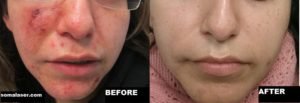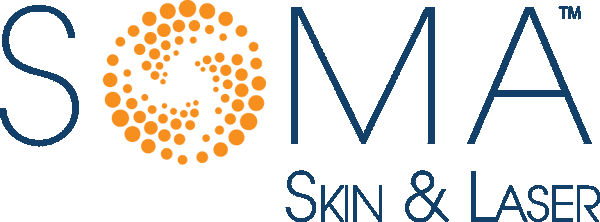Call For An Acne Consultation Today
973-763-7546
About acne
Acne vulgaris is a common disorder, prevalent among teen-agers, but often starting even earlier. It is a multifactorial disorder of the pilosebaceous unit—the structure in the skin from which hair originates and that secretes an oily substance termed sebum. Acne can result in lesions that range from open and closed comedones to inflammatory papules, pustules, nodules, and even deep cysts. Lesions are usually located on the face and neck, upper trunk and back—areas with a high number of sebaceous glands. Although acne is often thought of as a problem of teenagers, it can persist into the third and fourth decades of life. It can have a profound psychosocial impact on those afflicted.

What are the different type of acne blemishes?
- Open and closed comedones. Comedones are non-inflammatory lesions—inflammatory cells of the immune system are absent. An open comedone, commonly called a “blackhead”, looks like a pore filled with a black substance; this is not dirt but a substance derived from keratin—a protein that makes up much of the skin’s mass. A closed comedone, also known as a “whitehead”, looks like a flesh-colored papule.
- Inflammatory papules, pustules and nodules. Inflammatory lesions range from papules to deep cysts, depending on the exuberance of the inflammatory reaction. If superficial, they will usually appear red and may drain pus.
- Sinuses. Nodular acne can lead to draining sinus tracts.
- Scars. Depressed, pitted, or atrophic scars can form at sites of acne. Less often, acne scarring will result in keloid formation, especially on the trunk and especially in those with darker skin types
What makes acne worse?
Acne vulgaris can be made worse by androgen excess, as occurs in certain disorders such as polycystic ovary syndrome. Exogenous androgenic steroids, such as used illegally by athletes, can also cause acne. Important factors that contribute to the development of acne are: obstruction of the follicle; bacteria, especially propionibacterium acnes; and the influence of androgenic hormones on sebum production. All of this can lead to inflammation of the follicle. Eventually the follicle can rupture, spilling its contents into the dermis, eliciting a brisk inflammatory and foreign-body reaction.
Certain drugs, including lithium and glucocorticoids, can exacerbate acne or cause an acne-like condition. Emotional stress, menstrual cycle, and occlusion and pressure on the skin also contribute to lesions. Recently, it has been suggested that diets with a high glycemic load can contribute to acne vulgaris. Dairy consumption has also been linked to acne in some studies.
Special forms of acne
There are several special forms of acne, including acne conglobata, acne fulminans, acne with facial edema, acne excorieé, neonatal acne, occupational acne and chloracne, acne cosmetica and pomade acne, and acne mechanica.
What else can look like acne?
Other problems to be considered include steroid acne, bacterial folliculitis, acne rosacea, and adenoma sebaceum. Steroid acne begins abruptly within a few weeks of beginning steroid treatment. The lesions of steroid acne are usually uniform and, in the case of systemic steroids, typically concentrated on the upper trunk. Bacterial folliculitis—infection of the hair follicle—will usually exhibit a central hair in some of the lesions. Acne rosacea exhibits background erythema and telangiectasias, is not marked by comedones, and has a later age of onset. Adenoma sebaceum is a manifestation of the genetic disease tuberous sclerosis.
Acne vulgaris is usually diagnosed clinically. The patient is usually aware of the nature of the condition and has tried over-the-counter remedies prior to seeking medical care.
What are the treatments for acne?
Acne can be treated with topical agents and systemic agents, as well as light-sources, and non-antibiotic treatments.
Topical agents. The first line of therapy for superficial acne lesions is topical therapy. The most commonly used agent contain benzoyl peroxide (e.g. Benzac) or retinoids such as, tretinoin (Retin A), tazarotene (Tazorac), and adapalene (Differin). These drugs have comedolytic effects—they help resolve comedones. Topical antibiotics such as clindamycin and erythromycin are available as well, but are less commonly prescribed. Combination products with benzoyl peroxide and clindamycin are commonly used (e.g. Onexton, Duac, Benzaclin). A regimen of a topical retinoid (e.g. Retin A) at bedtime and benzoyl peroxide in the morning is prescribed by many dermatologists.
Systemic antibiotics. Inflammatory lesions respond well to systemic antibiotics, especially tetracylcines (e.g. tetracycline, doxycycline, minocycline, sarecycline) and erythromycin.
Systemic retinoids. Oral isotretinoin is used for patients with severe acne that does not respond to other measures. The drug decreases sebum production, follicular keratin formation, and bacterial counts. Side effect are nearly universal and include chapped lips and dry skin. Systemic side-effects include elevation in liver enzymes and abnormalities of lipid metabolism. Most significantly, isotretinoin is teratogenic and cannot be used in pregnant women or in women that might become pregnant. Birth control measures and rigorous monitoring are necessary to ensure compliance. Patients must be registered in a special monitoring program (iPledge), administered by the drug’s manufacturer. The risks and benefits must be discussed fully with an experienced physician.
Oral contraceptive pills (OCP). OCPs are beneficial in some acne patients. Antiandrogens, such as spironolactone, may also be helpful.
Photodynamic therapy and lasers. More recently, lasers, photodynamic therapy and other light sources have been used in the treatment of acne vulgaris, particularly for inflammatory lesions.
In photodynamic therapy (PDT), light interacts with a compound called protoporhyrin IX, which is produced by the bacterium P. acnes. This causes the generation of reactive singlet oxygen and the destruction of the bacteria. Various light sources can be used, including laser, IPL, and LED devices. Other lasers target the sebaceous gland, these include near infrared lasers, and radiofrequency devices. A sensitizer such as 5-aminlevulinic acid (ALA) can be applied for up to several hours prior to blue light, IPL or laser. ALA accumulates selectively in the pilosebaceous unit, targeting partial destruction when exposed to the light source.
Acne facials. Acne facials, in which the clogged pores are cleaned out, is often very useful for stubborn comedones.
Education. Topical treatment with benzoyl peroxide or retinoids can cause skin irritation, leading to apparent initial worsening, which resolves over a few weeks. If taking systemic retinoids, patients must be counseled on side-effects, especially the risk of birth defects. Since acne vulgaris is a chronic condition, clear oral and written instructions on the treatment regimen must be given to ensure compliance.
Abtibiotic-free acne treatments. With increasing concern about antibiotic resistant and the skin/gut connection, we also offer acne treatments that do not rely on systemic antibiotics.
What is the prognosis for acne vulgaris?
With treatments, acne vulgaris is a manageable disease with an excellent prognosis for most patients. If sufficient response is not observed to conservative treatments, additional medications or modalities can be used, as described above. Even without treatment, acne eventually resolves for most, but there is no predicting how long the course may be. Severe acne lesions may leave scars. These can be treated with dermabrasion, chemical peels, laser resurfacing, dermal fillers, microneedling, and other modalities, with variable efficacy.
